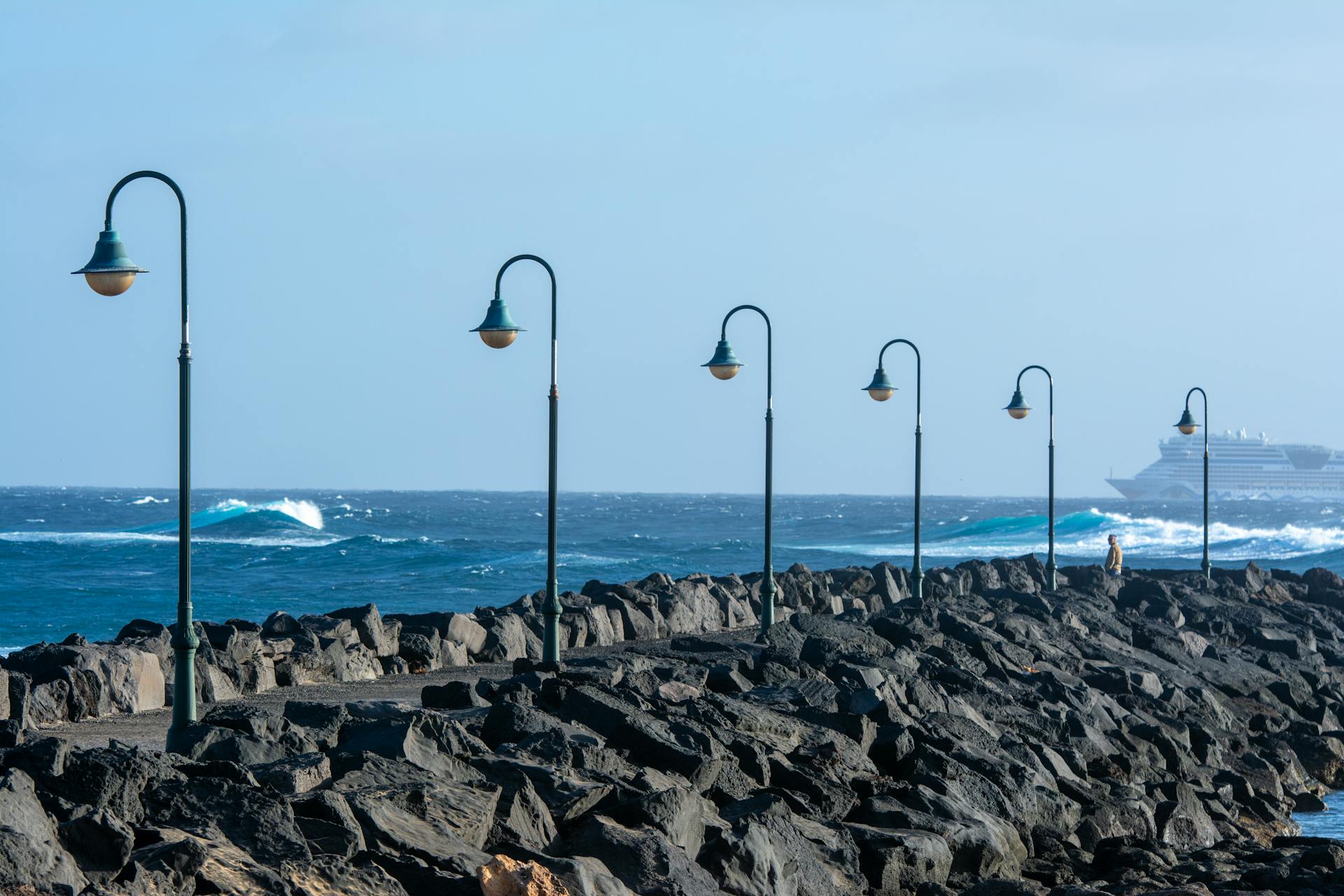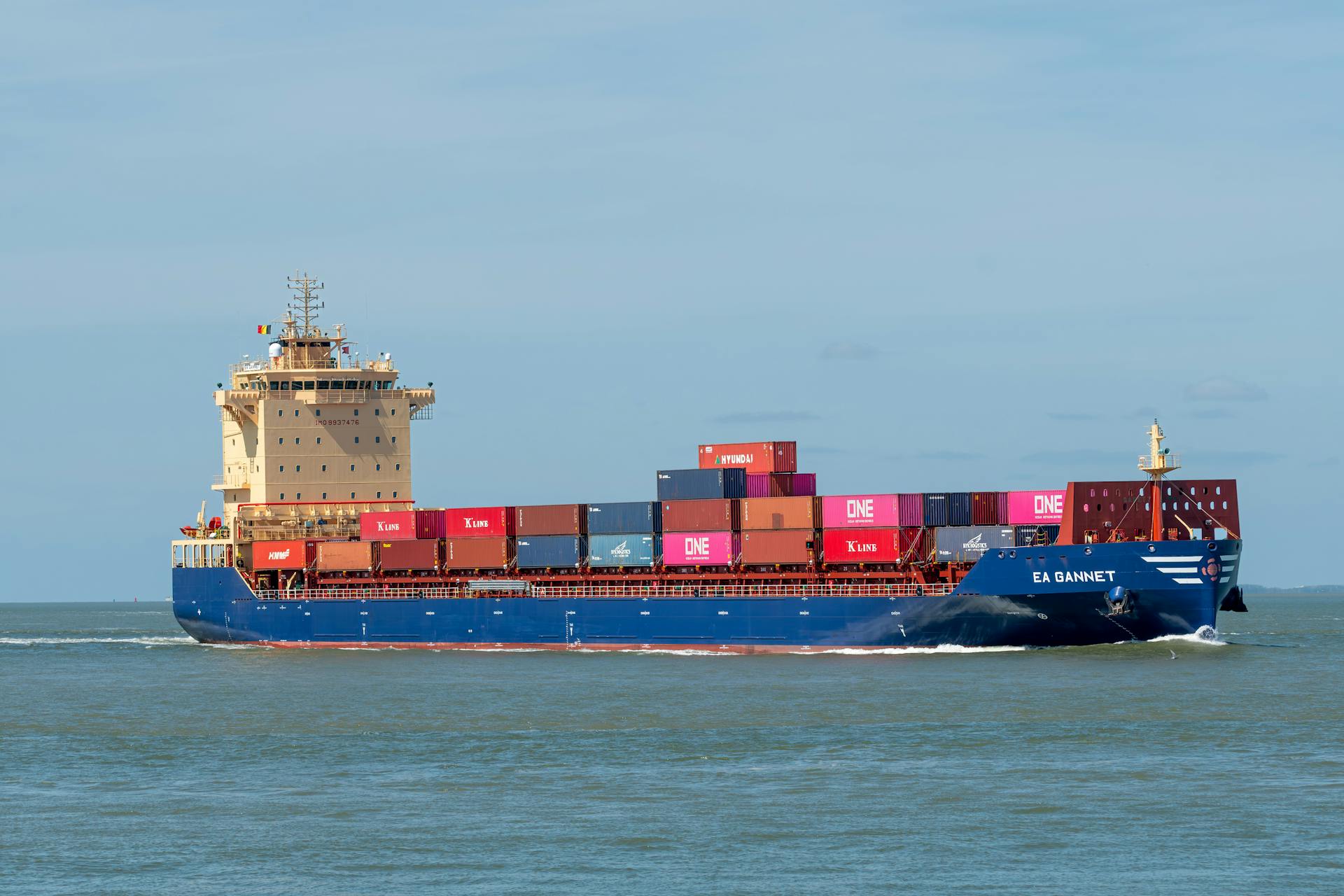
Sea transport systems are the backbone of global trade, with over 90% of the world's goods being transported by sea. This is due in part to the fact that ships can carry massive amounts of cargo, with some vessels capable of transporting over 20,000 containers.
The global shipping industry is a complex network, with thousands of ships traveling across the world's oceans every day. The busiest shipping lanes are found in the Strait of Malacca, which connects the Indian and Pacific Oceans.
Containerization has revolutionized sea transport, allowing for faster and more efficient loading and unloading of cargo. The first container ship was introduced in the 1950s, and since then, containerization has become the standard for global trade.
Broaden your view: Biggest Oversize Load in the World
Shipping Types
Shipping types vary greatly, with liner shipping being a key player in transporting manufactured and semi-manufactured goods, as well as bulk commodities in small quantities.
Liner shipping is all about speed, reliability, and high service levels, making it a crucial part of an integrated production operation. This is because there are so many parcels to handle on each voyage, requiring an organization-intensive approach.
Specialized shipping services, on the other hand, cater to difficult cargoes like cars, forest products, and refrigerated cargo, which demand higher service levels than bulk shipping.
You might enjoy: Freight Forwarding Service to Germany
Bulk Shipping
Bulk shipping is a distinctive business that involves carrying large parcels of raw materials and bulky semi-manufactures.
Bulk vessels typically complete about six voyages with a single cargo each year, which means they handle few transactions.
The average revenue of bulk shipping depends on a dozen negotiations per ship each year.
Low service levels in bulk shipping result in little overhead required to run the ships and organize the cargo.
Liner Shipping
Liner shipping is an organization-intensive business that handles many small parcels of general cargo.
This includes manufactured and semi-manufactured goods, as well as small quantities of bulk commodities.
Speed, reliability, and high service levels are crucial in liner shipping because the transport leg forms part of an integrated production operation.
Published prices are relied upon in liner shipping, although major customers often negotiate prices as part of a service agreement.
This business model requires a high level of organization to manage the many transactions involved.
Related reading: Freight Forwarding Service to South Korea
Container Shipping
Container shipping is a convenient way to transport goods by sea. There are two main types of container shipping: Full Container Load and Less than Container Load.
Full Container Load, or FCL, is ideal for cargo that exceeds 46 feet or 10 standard pallets. Cargo travels in the container without sharing space with other products, allowing for a single series of safety parameters to be set up for the goods.
Less than Container Load, or LCL, is used when goods from different freight agents can share space in the same container. This is suitable for cargo with a volume between 6.5 to 42.6 feet.
Full Container Load
Full Container Load is a game-changer for shipping large volumes of cargo, as it allows for cargo to travel in a container without sharing space with other products.
One major benefit of FCL is that it's ideal for cargo volumes that exceed 46 feet or 10 standard pallets.
Less Than Container Load (LCL)
Less Than Container Load (LCL) is used when goods from different freight agents can share space in the same container.
This type of shipping is opposite to the Full Container Load (FCL), where cargo volume must be larger.
In LCL, cargo volume must be smaller, between 6.5 to 42.6 feet.
The business of LCL relies on published prices, though nowadays the prices are negotiated with major customers as part of service agreement.
Specialized Vessels
Specialized Vessels are designed to handle specific types of cargo, such as cars and forest products.
These vessels offer higher service levels than bulk shipping, which is a more general type of shipping.
Specialized shipping services invest in ships that are tailored to the unique needs of these cargoes, providing a more efficient and effective transportation solution.
For example, cars require specialized handling and storage, which can be provided by ships designed specifically for auto transport.
Check this out: Stowage Plan for Container Ships
Specialized Shipping
Specialized shipping services transport difficult cargoes such as cars, forest products, refrigerated cargo, chemicals, and liquified gas. These trades require specialized ships and offer higher service levels than bulk shipping.
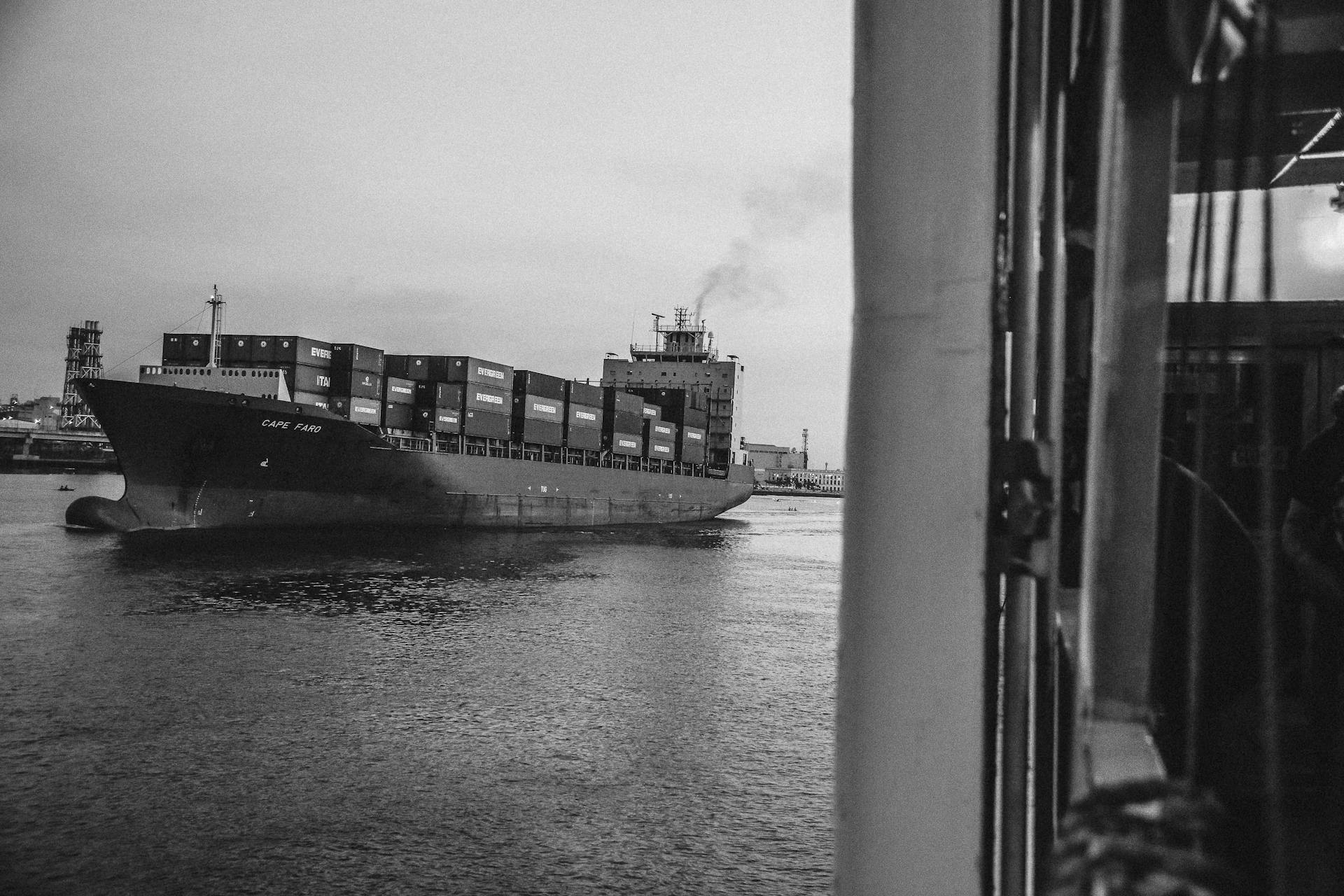
The five most important specialized cargoes are cars, forest products, refrigerated cargo, chemicals, and liquified gas. This is because they require unique handling and storage conditions.
Specialized ships are designed to handle these types of cargoes, and service providers invest in them to offer higher service levels. This is a significant advantage for shippers who need to transport these types of goods.
Liquified gas, for example, requires specialized tanks and handling equipment to prevent accidents and ensure safe transportation. This is just one of the many reasons why specialized shipping services are essential for certain types of cargoes.
Suggestion: List of Cargo Types
Open Top
Open Top containers are a type of specialized vessel that can accommodate massive trees, industrial machinery, yachts, or railroad cars that wouldn't fit in standard containers.
They usually have a removable tarpaulin roof, which makes it easier to load and unload cargo. This design feature is essential for transporting oversized items.
One of the notable characteristics of Open Top containers is the presence of doors on the sides, facilitating the loading and unloading of cargo. This is particularly useful for items that need to be moved in and out of the container quickly.
These containers are perfect for transporting items that are too large for standard containers, making them a valuable asset for shipping companies and cargo owners alike.
Logistics and Operations

The sheer scale and volume of the maritime industry is a significant challenge in sea transport logistics, with thousands of vessels moving billions of tons of cargo across the world's oceans every year.
Each type of vessel, from container ships to bulk carriers, requires specific handling and logistics considerations, adding to the complexity of sea transport operations.
Optimizing vessel routing and cargo stowage can improve the efficiency and cost-effectiveness of sea transport logistics.
Streamlining port operations and cargo handling is also crucial for reducing delays and disruptions in sea transport.
Utilizing advanced technologies such as real-time tracking and data analytics can provide valuable insights and optimization opportunities for sea transport operations.
Internal logistics and operational efficiencies play a critical role in sea transport logistics, with many opportunities to improve efficiency and cost-effectiveness.
For more insights, see: Logistics and Freight Forwarding
Challenges and Solutions
Sea transport logistics is a complex and challenging aspect of the global supply chain, requiring careful planning and management to ensure smooth and efficient operations.

The sheer scale and volume of the maritime industry is a daunting task, with thousands of vessels moving billions of tons of cargo across the world's oceans every year.
Navigating the regulatory landscape of international shipping is crucial, as it involves understanding trade compliance and customs processes, as well as adapting to changing regulations and trade dynamics.
Effective risk management and contingency planning are essential to mitigate the impact of weather conditions, port congestion, and unforeseen disruptions on shipping schedules and logistics operations.
Streamlining port operations and cargo handling can improve the efficiency and cost-effectiveness of sea transport logistics, while utilizing advanced technologies like real-time tracking and data analytics can provide valuable insights and optimization opportunities.
The complexity of sea transport logistics requires a comprehensive and holistic approach to managing the myriad of challenges involved, from vessel operations to supply chain integration.
Explore further: Trade Facilitation
Embracing Technology and Innovation
The sea transport industry has undergone significant transformations in recent years, driven by the integration of technology and innovation. This has led to the transformation of sea transport logistics.
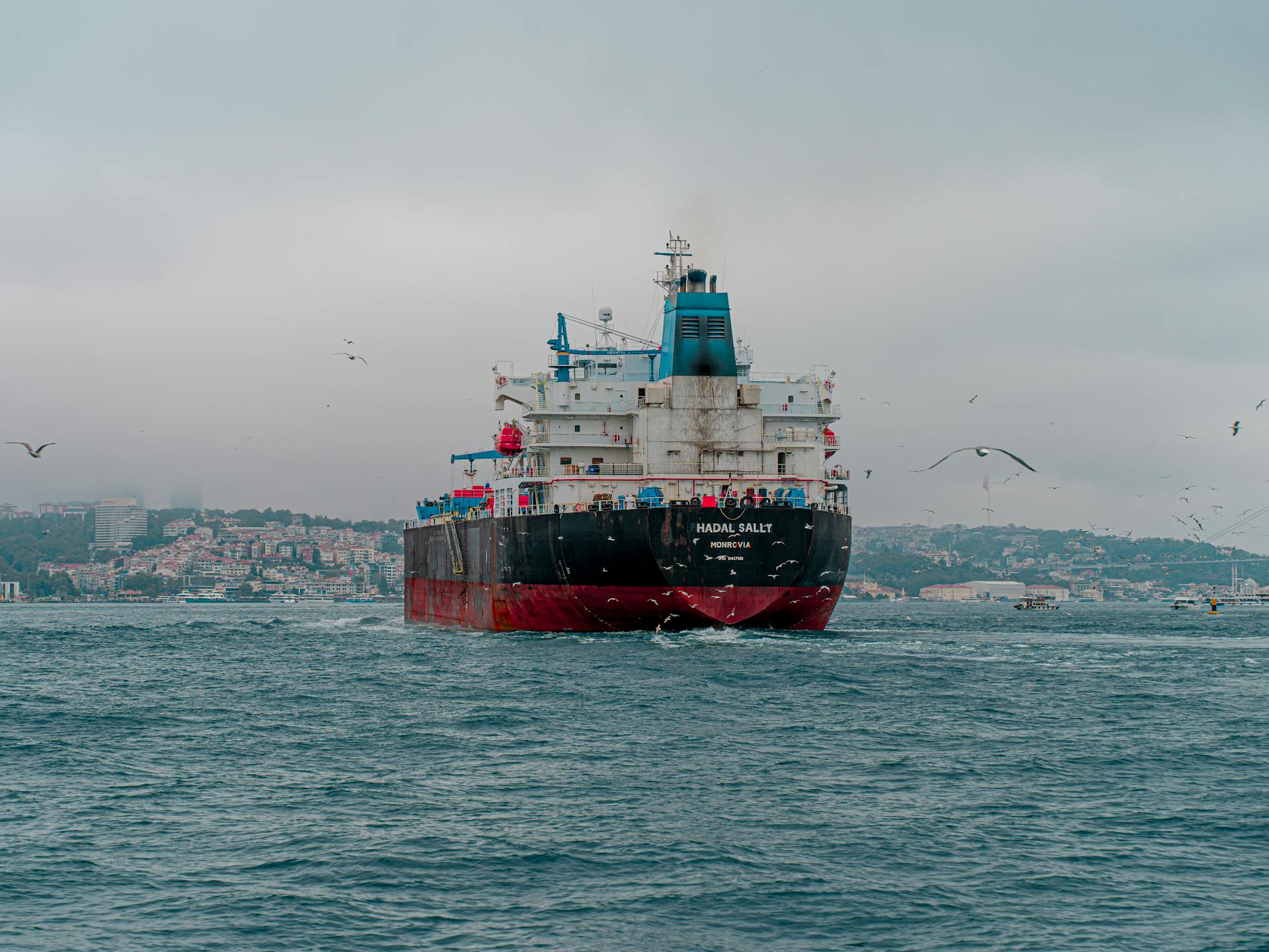
Digitalization has streamlined the process of managing and tracking shipments, enabling real-time visibility and control over cargo movements. This has improved efficiency and productivity in logistics operations.
The use of IoT devices and blockchain has enabled businesses to optimize their supply chain processes and mitigate risks associated with sea transport. With these technologies, businesses can now track shipments in real-time and ensure that cargo is delivered safely and securely.
Data analytics and AI have provided valuable insights and predictive capabilities in sea transport logistics. By analyzing trends and patterns, businesses can identify potential disruptions in the supply chain and make proactive decisions to mitigate risks.
The integration of data analytics and AI has also enabled businesses to optimize routes, schedules, and resources, leading to cost savings and improved customer satisfaction. This is a significant advantage in an industry where efficiency and cost-effectiveness are crucial.
Automation and robotics have enhanced cargo handling and storage capabilities in ports and terminals, enabling faster turnaround times and minimizing human error. This has improved the overall operational efficiency of sea transport.
The development of eco-friendly and fuel-efficient vessels has contributed to reducing environmental impact and improving operational efficiency. This is a critical aspect of the industry, as businesses strive to minimize their environmental footprint.
For more insights, see: Freight Brokerage Industry

By embracing technology and innovation, businesses can stay ahead in the rapidly evolving landscape of sea transport logistics. This requires investments in technology, talent, and partnerships to navigate the complexities of the industry.
In conclusion, the integration of technology and innovation has revolutionized the sea transport industry, providing new opportunities for efficiency, sustainability, and growth. Businesses that adapt to these advancements will be well-positioned to thrive in an increasingly competitive market.
For your interest: Freight Technology
Emerging Trends
As we look to the future of sea transport systems, several emerging trends are gaining momentum. One of these trends is the increasing use of liquefied natural gas (LNG) as a cleaner-burning fuel source, with the International Maritime Organization (IMO) setting a goal for all new ships to use LNG by 2030.
The adoption of LNG is expected to reduce greenhouse gas emissions by up to 25% compared to traditional fossil fuels. This shift is already underway, with many major shipping companies investing in LNG-powered vessels.
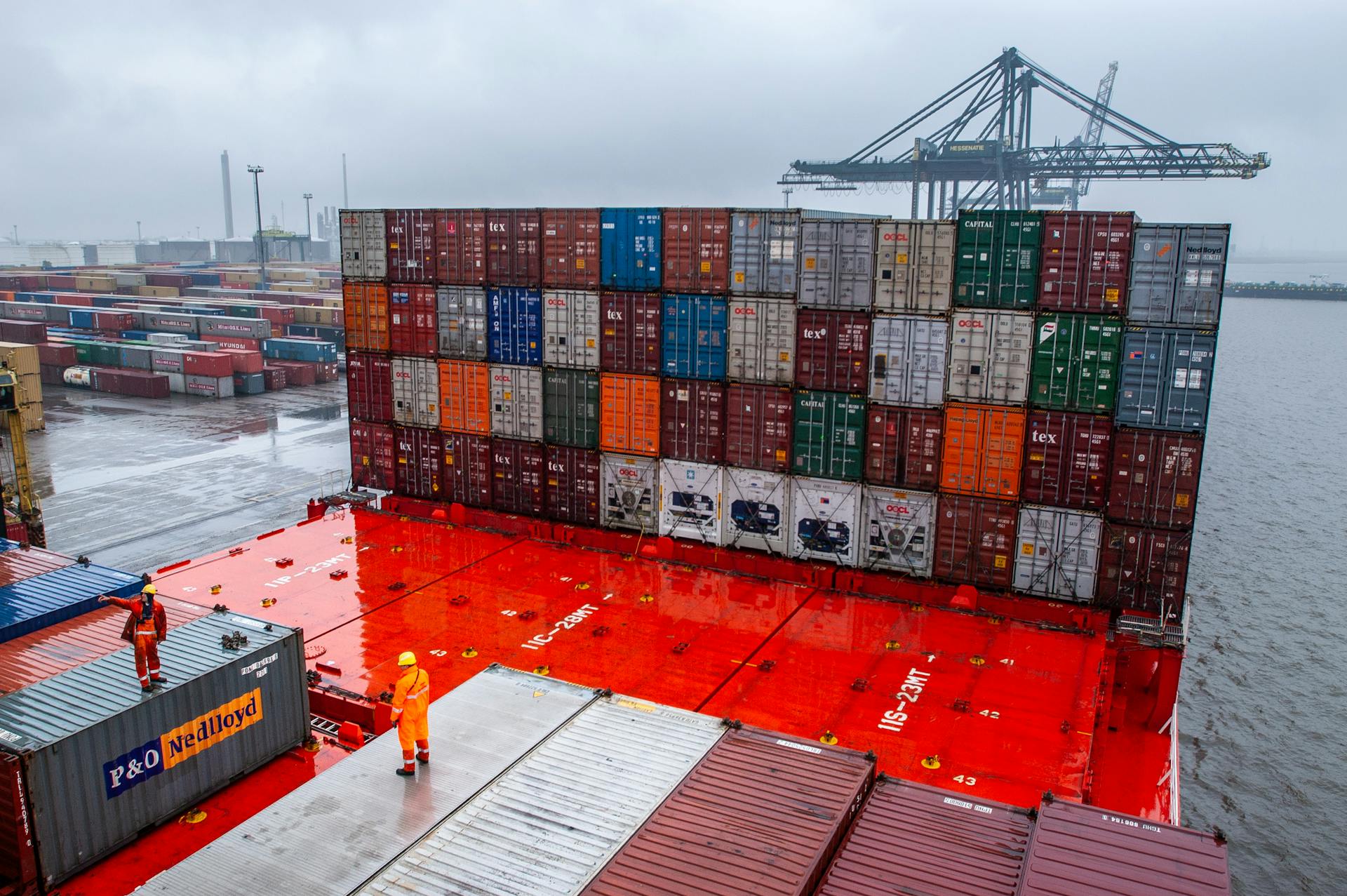
Advancements in digitalization and automation are also transforming the sea transport industry. The use of data analytics and artificial intelligence (AI) is enabling more efficient route planning and real-time monitoring of vessel performance.
This increased efficiency is expected to lead to significant cost savings and reductions in fuel consumption. For example, a study by the World Shipping Council found that the use of advanced navigation systems can reduce fuel consumption by up to 10%.
Another emerging trend is the growth of autonomous shipping, with several companies already testing and deploying autonomous vessels. These vessels use a combination of sensors and AI to navigate and operate without human intervention.
The potential benefits of autonomous shipping are significant, including increased safety and reduced labor costs. However, there are also challenges to be addressed, such as regulatory frameworks and public acceptance.
The increasing use of alternative fuels, such as hydrogen and biofuels, is also expected to play a major role in the future of sea transport systems. These fuels offer a lower carbon footprint than traditional fossil fuels and can be produced from renewable sources.
The development of new ship designs and propulsion systems is also underway, with a focus on reducing emissions and increasing efficiency. For example, the use of wind-assisted propulsion systems can reduce fuel consumption by up to 20%.
Sources
- https://en.wikipedia.org/wiki/Sea_transport_systems
- https://porteconomicsmanagement.org/pemp/contents/part6/ports-and-container-shipping/emerging-global-maritime-freight-transport-system/
- https://www.sintef.no/en/latest-news/2020/a-roadmap-for-smart-and-autonomous-sea-transport-systems/
- https://www.cnslogistic.com/a-navigating-the-depths-the-complexity-of-sea-transport-logistics.html
- https://blog.akzent.mx/en/sea-transportation-in-a-nutshell
Featured Images: pexels.com
